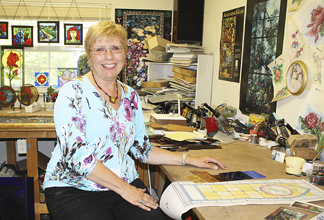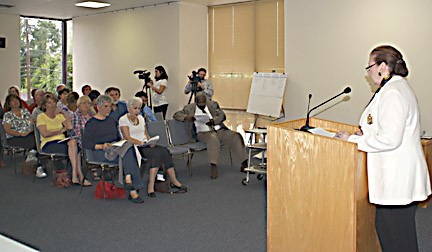Alachua resident designs and creates works of art


Photo 1: Working out of her home, Alachua resident Linn Check-Mathis is still doing what she loves – creating stained glass pieces of art, many of which have been installed in area churches. Photo 2: The stained glass window for The Family Church in Gainesville is one of the more difficult pieces Check-Mathis has created. The large window had 13 separate sections with over 800 pieces of glass in the entire work.
ALACHUA – Light speckled through the red and green stained glass. Linn Check-Mathis had been meaning to place such a stained glass window in the door since she and her husband moved in 10 years ago, but hadn’t gotten around to it until the last three or four years.
It’s kind of like the shoemakers’ kids running around without shoes, she said.
The 67-year-old Alachua resident is the founder of North Florida Stained Glass, which she runs out of her home. She’s been working in the art since the 1980s, and in the past she had a shop on Alachua’s Main Street.
“After 32 years, I’m so lucky I still love what I do,” she said.
One of her most recent pieces is a large stained glass window for St. John’s United Methodist Church in Alachua. Shades of yellow, red, green and a hint of blue make up the color palette of the window. It was installed just in time for Sunday morning’s Easter service.
Charlie Fink, a trustee with the church, said he was stunned by how quickly the window was finished. It was greatly appreciated in the sunrise service on Easter Sunday.
“It was absolutely stunning to just watch the windows come to life as the sun rose over the horizon,” Fink said.
Linn’s passion for her art began in Rockford, Mich., where she started taking classes in making stained class. After taking a part-time job at a stained-glass business, she moved up to management. She then moved to Alachua, where she founded her own shop.
Her art even led her to find her husband, Rich Mathis. He had been taking glass art classes in Gainesville at the time. Linn was wearing a shirt that said, “Star light, Star bright, Where the Hell is Mr. Right?” when he walked into her shop under the blinking light on Alachua’s Main Street. A couple of years later, the couple was walking down the aisle.
Her career has also led her to integrate others’ stories into her art.
When she created a stained glass for Holy Trinity Episcopal Church in Gainesville after it burned to the ground, she was able to incorporate some of the ashes from the burned building in the window. Another customer wanted a window, so she made the illusion of a window out of an old window frame.
These days, Check-Mathis does commission pieces and is experimenting with other forms of glass art. She said she could never leave her line of work that allows such creativity and freedom.
“If I had to go back to a nine to five job, I’d be in serious trouble,” she said.
The glass pieces, which can be as large as 8-by-12 feet, can be physically difficult, she said. One of the more difficult pieces she’s done was a stained glass window for The Family Church in Gainesville. The large window had 13 separate sections with over 800 pieces of glass in the entire work.
The dark blue background of the window contrasts the large gold cross outlined in radiating lines of red. She admits she didn’t know if all of the pieces would match up until after it was installed.
Stained glass pieces can take anywhere from three weeks to three months to complete. First, she sketches out what she wants the piece to look like and replicates that sketch to make it true to scale. Then, she hand cuts the glass and lines it with a special metal to hold the pieces together. After the glass pieces are soldered together, they are installed.
Check-Mathis said creating a stable window has always been important to her. She wanted to prove wrong those who said women couldn’t make stable stained glass and create a quality product for her customers, she said.
Check-Mathis isn’t limited to just making stained glass pieces. She also began experimenting with fused glass and jewelry in the past couple of months.
“The list of what I want to do gets longer as I get older, not shorter,” she said.
A round glass plate with a smiling cat wearing a cheese hat rests on a table. Her inspiration for the piece was a love for her cat, Bobbi, and the Green Bay Packers.
A fused plate like the one of her cat may go into the kiln four separate times before it’s completely finished.
She said she finds the new types of glass art she’s been working with refreshing. Each piece she works on, Check-Mathis sees as a different challenge.
“Every one has its own potential to be fun and different and exciting,” she said.
# # #
E-mail mharvard@alachuatoday.com




